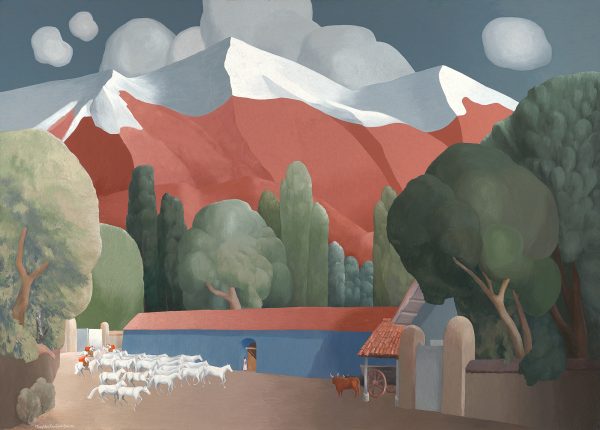
Near Los Andes
Smith, Houghton Cranford
1944
Artwork Information
-
Title:
Near Los Andes
-
Artist:
Smith, Houghton Cranford
-
Artist Bio:
American, 1887–1983
-
Date:
1944
-
Medium:
Oil on canvas
-
Dimensions:
35 3/4 x 49 3/4 in.
-
Credit Line:
Wichita Art Museum, Roland P. Murdock Collection
-
Object Number:
M54.44
-
Display:
Not Currently on Display
About the Artwork
The Chilean mountain scene Near Los Andes looms before the viewer like some uncanny moonscape, eliciting feelings of curiosity, disquiet, and pleasure. What ought to be familiar is unexpectedly strange. All-natural forms including the clouds have been modeled into distinctly contoured shapes of uniform surface and gray-toned local color. Set against this monumental backdrop of razor-edged, snow-capped terra cotta mountains, an encircling and densely crowded grove of bulbous trees, steel-blue sky, and rock-like cloud formations is a modest man made world of adobe ranch buildings, walled interior courtyard and tiny figures of animals and people. However, the foreground action of three vaqueros driving a herd of all-white horses into center stage and a woman standing in a doorway waving fails to animate the scene. Given the archetypal simplicity of forms and color that characterize the scene, the little figures look more like miniature toys set in a diorama than they do real creatures. The mood of mystery and foreboding that pervades the scene arises not from its exotic foreign setting but entirely from formal qualities—cool, tonal color palette, reductive yet peculiar shapes, sharp definition of contours, and strong direct lighting.
In the early years of his career Houghton Cranford Smith practiced a lively colorist plein air interpretation of landscape. His favored venues were Provincetown and Cape Cod where he had perfected his craft, and the ranches and mountain villages of Chili, where he spent 1916 through 1920 visiting with family friends, exploring an exotic and friendly country, and making sketches and paintings. In the early 1930s in Paris Smith’s studies with French Purists Amedee Ozenfant and Andre Lhote prompted a dramatic transformation of his aesthetic into the kind of haunting surrealist stage-set landscapes exemplified by Near Los Andes.
Near Los Andes references an actual place as well as personal experience. Smith explained that he based the scene upon a sketch he had made of a ranch located just outside the town of Los Andes, Chili, one of the many places that he remembered so fondly for its natural beauty and the warm hospitality of the people. By the time Smith executed this work; however, he worked from memory and imagination rather than from direct observation, and had refined his own unique formalist language. The acquisition of Near Los Andes is singularly rewarding for its representation of a highly original and yet little-known American modernist.